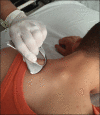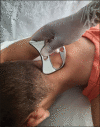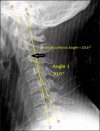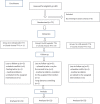Short-term effects of instrument-assisted soft tissue mobilization compared to algometry pressure release in tension-type headache: a randomized placebo-controlled trial
- PMID: 35674120
- PMCID: PMC10288918
- DOI: 10.1080/10669817.2022.2082637
Short-term effects of instrument-assisted soft tissue mobilization compared to algometry pressure release in tension-type headache: a randomized placebo-controlled trial
Abstract
Purposes: To compare the effectiveness of instrument-assisted soft tissue mobilization (IASTM) and pressure algometry with sham ultrasound (control group) on the clinical measures of headache, pressure pain threshold (PPT) of upper trapezius and suboccipital muscles and cervical alignment in patients with tension type headache (TTH).
Methods: Seventy-two patients with TTH of both genders were randomly allocated to 3 experimental groups: a) the IASTM group (n=24), b) pressure algometry group (n=24), and c) sham ultrasound control group (n=24). Headache frequency and disability, pressure pain threshold of upper trapezius and suboccipital muscles, cervical lordosis angle (CA) and anterior head translation (AHT) were measured four weeks before and after intervention. Moreover, headache frequency was followed up for two more weeks after intervention.
Results: Statistically significant improvements (P <0.05; effect size ranges 1.1-1.9) were observed in all outcome measures following IASTM compared to the other two intervention methods. In the IASTM group, the headache frequency decreased from 15 to 2 days/month. Also, headache disability decreased from 19 to 10. Further, CA increased from 17.5° to 31.4° and AHT decreased from 24.1 to 15.5 mm. The pressure algometry group showed significantly lower headache frequency at the follow-up (P < 0.01) than the sham ultrasound control group. However, Similar findings in the other evaluated outcomes were found between the pressure algometry and sham ultrasound control groups (P ˃ 0.05).
Conclusion: The results of the present study indicate the effectiveness of IASTM in improving headache symptoms and cervical alignment in patients with TTH.
Keywords: Cervical alignment; Tension-type headache; instrument-assisted soft tissue mobilization; manual therapy; myofascial trigger points.
Conflict of interest statement
No potential conflict of interest was reported by the author(s).
Figures





References
-
- Waldie KE, Buckley J, Bull PN, et al. (2015). Tension-type headache: a life-course review. J Headache & Pain Manage. 1(1), 1–9. Retrieved fromhttp://headache.imedpub.com/https://researchspace.auckland.ac.nz/doc...
-
- Buse DC, Loder EW, Gorman JA, et al. (2013). Sex differences in the prevalence, symptoms, and associated features of migraine, probable migraine and other severe headache: results of the American migraine prevalence and prevention (AMPP) study. Headache. 53(8):1278–1299. - PubMed
-
- Lardon A, Girard MP, Zaïm C, et al. (2017). Effectiveness of preventive and treatment interventions for primary headaches in the workplace: a systematic review of the literature. Cephalalgia. 37(1):64–73. - PubMed
Publication types
MeSH terms
LinkOut - more resources
Full Text Sources
